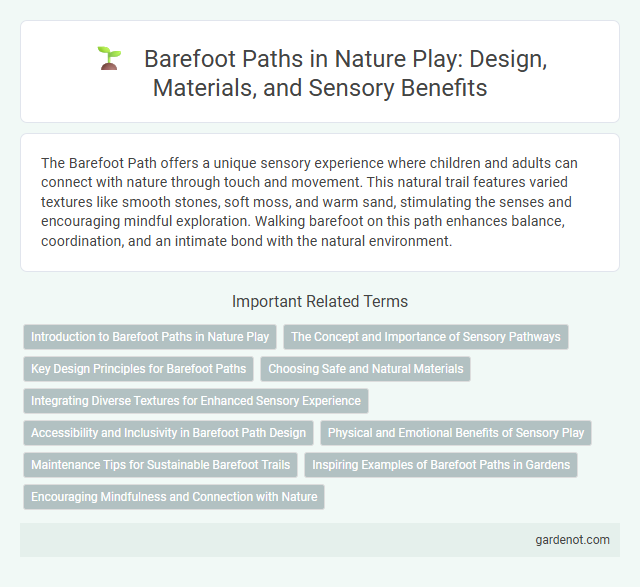The Barefoot Path offers a unique sensory experience where children and adults can connect with nature through touch and movement. This natural trail features varied textures like smooth stones, soft moss, and warm sand, stimulating the senses and encouraging mindful exploration. Walking barefoot on this path enhances balance, coordination, and an intimate bond with the natural environment.
Introduction to Barefoot Paths in Nature Play
Barefoot paths in nature play provide children with direct sensory engagement by encouraging walking barefoot on organic materials like soil, grass, wood chips, and stones. These paths enhance tactile stimulation, improve balance, and promote natural foot development through varied textures and uneven surfaces. Integrating barefoot paths in outdoor play areas fosters a deeper connection with the environment and supports holistic physical and cognitive growth.
The Concept and Importance of Sensory Pathways
Barefoot paths, integral to nature play, stimulate sensory development by engaging multiple receptors in the feet, enhancing balance, coordination, and proprioception. These sensory pathways expose children to diverse textures such as sand, wood, and stone, fostering tactile exploration and strengthening neural connections. Incorporating barefoot paths in play environments supports holistic growth, sensory integration, and a deeper connection to natural surroundings.
Key Design Principles for Barefoot Paths
Key design principles for barefoot paths emphasize the use of diverse natural materials such as smooth stones, sand, wood, and soil to stimulate sensory experiences and enhance foot reflexology benefits. Incorporating varying textures, temperatures, and firmness levels encourages balance, coordination, and mindfulness during play. Proper drainage, safe material selection, and seamless integration with surrounding landscapes ensure durability, safety, and an immersive connection to nature.
Choosing Safe and Natural Materials
Selecting safe and natural materials for a barefoot path is essential to ensure a secure and comfortable experience for children and adults. Organic elements such as smooth river stones, untreated wood chips, and natural rubber mulch provide tactile stimulation while minimizing risks of splinters or sharp edges. Prioritizing non-toxic, sustainably sourced materials supports environmental health and enhances the sensory connection to nature during play.
Integrating Diverse Textures for Enhanced Sensory Experience
Barefoot paths integrate diverse textures such as smooth pebbles, coarse bark, soft moss, and cool sand to stimulate the senses and deepen connection with nature. Incorporating a variety of natural materials enhances tactile feedback, promoting sensory development and mindfulness. These textured surfaces encourage exploration, balance improvement, and improved proprioception in both children and adults.
Accessibility and Inclusivity in Barefoot Path Design
Designing barefoot paths with accessibility and inclusivity ensures that individuals of all ages and abilities can engage with nature comfortably and safely. Incorporating varied surface textures, clear signage, and gradual gradients accommodates sensory experiences and mobility needs. These features promote equal participation and enhance the therapeutic benefits of nature play for diverse communities.
Physical and Emotional Benefits of Sensory Play
Walking barefoot along a nature play barefoot path stimulates nerve endings, enhancing sensory processing and improving balance and coordination. This tactile experience promotes emotional well-being by reducing stress and fostering mindfulness through direct contact with natural textures like soil, grass, and stones. Engaging in sensory play barefoot supports physical development and encourages a deeper connection with the environment, benefiting overall mental health.
Maintenance Tips for Sustainable Barefoot Trails
Maintaining sustainable barefoot paths requires regular inspection to remove debris, ensuring surface materials like smooth stones, bark, or sand remain clean and evenly distributed to prevent injury. Implementing natural erosion controls such as mulch layers and gentle grading preserves trail integrity and supports local flora. Seasonal adjustments, including moisture monitoring and clearing overgrowth, enhance durability and provide a safe, immersive nature play experience.
Inspiring Examples of Barefoot Paths in Gardens
Barefoot paths in gardens, such as the vibrant sensory trail at Denmark's Skulpturparken and the natural stone layout at Germany's Berlin Botanical Garden, offer immersive tactile experiences that stimulate sensory awareness and connection with nature. These paths integrate diverse textures like smooth pebbles, soft moss, and warm wood chips, promoting mindfulness and physical well-being. Incorporating local materials and thoughtful design enhances engagement, making barefoot paths essential features in therapeutic and educational garden landscapes.
Encouraging Mindfulness and Connection with Nature
A barefoot path enhances sensory engagement by stimulating nerve endings through natural textures like grass, bark, and stones, promoting mindfulness and present-moment awareness. Walking barefoot on varied surfaces fosters a deep connection with nature, encouraging users to slow down and observe their surroundings intentionally. This immersive experience supports mental well-being by grounding individuals and reducing stress through direct contact with the earth's elements.
Barefoot path Infographic

 gardenot.com
gardenot.com